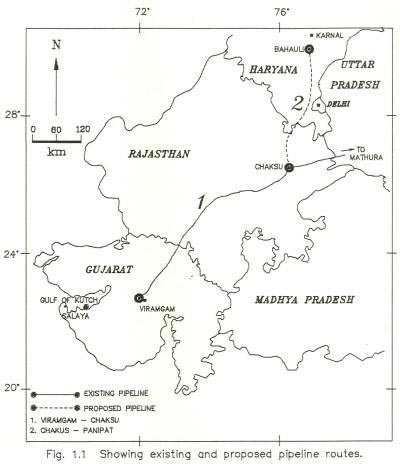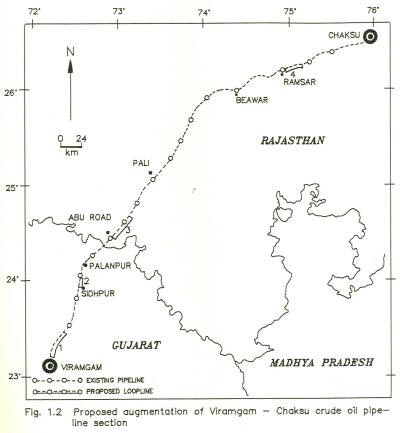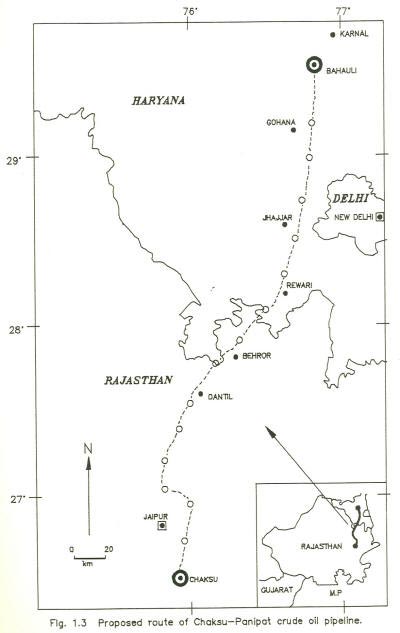|
Worldwide pipeline mileage under construction is now 86,000 miles and it is expected to maintain the same pace throughout the 1990s to meet the ever increasing demand for clean burning fuel (Ives, 1993). Likewise, India's rapid industrialisation and the resultant demand for crude and petroleum products to meet the power and energy demand has led to unprecedented expansion for pipeline network" in the country (WII, 1994). As a result, India, with 7,800 km of existing pipeline network will have proposed expansion by additional 7865 km of pipelines by the three major oil companies of India, viz., Oil and Natural Gas Commission (ONGC), Gas Authority of India (GAIL) and Indian Oil Corporation Limited (IOCL). This includes the GAIL's proposal for a national gas grid linking north, west, south and east regions which would require 18,300 km length of pipelines (Ives, 1993).
Pipelines are by far the most superior mode of transport as they involve lower cost of production, conservation of fossil fuels, minimum product loss during transit and reduce pressure on rail and road transportation. But, pipelines have the disadvantage of causing considerable impacts upon the environment and the Wildlife values of the areas that are located en route (WII, 1993). However, these pipeline projects can be made to substantially mitigate such impacts and become environment friendly provided due consideration to the environmental concerns are given" at the conceptual and planning phases of these projects. In this case, the "concerns are choice of route, construction technology, pipeline design, and precautions in construction and post construction activities.
The Environmental Impact Assessment (EIA) studies of such pipeline projects focus on identification of potential impacts of proposed project, develop safeguards that will enable expansion to take place without significant damage to natural environment and or harmful effects on the people and wildlife that live in the area.
1.1 THE BACKGROUND AND RATIONALE OF THE PROPOSED PROJECT
The Planning Commission had constituted a "Working Group on Petroleum" for formulating the VIII Plan document pertaining to Petroleum industry in the country. As per the request of this Working Group, IOCL was requested to examine how best to use the increased production of Western onshore crude which was projected by ONGC as 8.75 MMTPA and 10.29 MMTPA for the years 1993-94 and 1999-2000 respectively. IOCL also examined the possibility of expanding the Gujarat Refinery, Koyali and submitted a feasibility report for setting up of a 3 MMTPA Crude Distillation Unit at the refinery. However, the latest projections (1993) of Crude Oil Production as per ONGC in Gujarat oil fields have dropped significantly to 5.62 MMTPA and 7.53 MMTPA for the years 1993-94 and 1999-2000 respectively. Realisation of the fact that actual production from western offshore oil fields may not reach even the revised projected levels, as much as 6.5 MMTPA of crude oil will have to be imported, and transported through the Salaya - Viramgam - Koyali section of the Salaya - Mathura Pipeline to meet the revamped requirement of Gujarat Refinery at 12.5 MMTPA. Moreover, the Salaya - Mathura Pipeline will also be required to feed crude oil to the extent of 6 MMTPA to Panipat Refinery, which is presently under execution. Therefore, the Salaya - Viramgam section of the Salaya - Mathura pipeline will have to carry crude oil to the extent of 20 MMTPA and Viramgam - Koyali section to transport 6.5 MMTPA of crude oil (IOCL, 1990a & b).
1.2 THE PROPOSED PROJECT
M/s IOCL proposes to augment the Viramgam-Chaksu (VC) section of the existing SMPL pipeline and lay one new pipeline i.e. the Chaksu-Panipat (CP) in order to meet the crude oil requirements of the Mathura and Panipat Refineries. Fig 1.1 shows the existing and proposed pipeline routes. The Viramgam-Chaksu (VC) section (605 Km) of the existing SMPL is proposed to be augmented from 7.5 MMTPA to 13.5 MMTPA by laying four loop lines of 110 Km length. The Chaksu - Panipat (CP) section will have a 345.7 Km long crude oil pipeline from Chaksu to the up-coming refinery site at Panipat with a capacity of 6 MMTPA.

The Table 1.1 provides details of the existing VC and proposed CP crude oil pipelines.
TABLE - 1.1 Details of the existing VC and proposed CP crude oil pipelines
|
Sr. No.
|
Section
|
Existing pipeline length (km)
|
Proposed pipeline length (km)
|
Proposed looplines no. (Total length in km)
|
|
1.
|
VC section
|
602.0
|
Nil
|
|
4(109.0)
|
|
2.
|
CP section
|
Nil
|
345.7
|
|
Nil
|
1.3 PROJECT SETTING, DESIGN AND DESCRIPTION
1.3.1 Viramgam - Chaksu (VC) section:
The VC section of the SMPL which is 605 Km long transports crude oil from Viramgam to Chaksu via Abu Road (Fig 1.2), Sidhpur, Kot and Sendra with pump stations at Viramgam and Abu Road. To augment this section from 7.5 MMTPA to 13.5 MMTPA, it is envisaged to upgrade the existing pump stations at Viramgam and Abu Road by replacement of pumping units with higher capacity units; installation of one additional pumping unit of same capacity at the existing Sidhpur, Kot and Sendra pump stations; constructing two new pump stations at Rajola and Ramsar; and by laying four loop lines of 110 Km length (IOCL, 1990a). The loop lines are required to be laid for a length of 38 Km from Viramgam, 16 Km from Sidhpur, 33 Km from Abu Road, and 23 Km from Ramsar. The loop lines will be laid in the ROW of the existing VC pipeline. The throughput of the VC section with a pipeline dimension of 24" OD X 0.281" WT APL 5L 52 Grade will be 13.5 MMTPA (2025 kl/hr).

1.3.2 Chaksu - Panipat (CP) section:
The CP section will have 345.7 km long crude oil pipeline from Chaksu to the proposed refinery site "at Panipat with a capacity of 6 MMTPA (IOCL, 1990b). The CP pipeline originates from Chaksu pump station of the existing SMPL, traverses north of Chaksu and passes through Shahpura, Kotputli, Rewari and Rohtak and terminates at the proposed Panipat Refinery site situated in Bahauli village, Panipat District, Haryana (Fig 1.3). The ROW to be acquired for the purpose of laying of the main line will be 18 m wide throughout the pipeline route. The entire proposed alignment passes mostly through the agricultural lands and avoids water logged grounds and rocky terrain except for a stretch of 2 Km. Road and railway crossings will be done by cased crossings while in case of rivers, canals and streams by submerged crossings. The throughput of the section with a pipeline dimension of 24" OD X 0.281" WT APL 5L 52 Grade will be 6 MMTPA (900 kl/hr).

1.4 SCOPE OF WORK
M/s IOCL had entrusted the Engineers India Limited (ElL), New Delhi to undertake the comprehensive EIA study on the proposed augmentation of SMPL and the proposed CP pipeline projects as this is required to comply with the Environmental Protection Act, 1986 and other legal enactments of the Ministry of Environment and Forests. The Wildlife Institute of India (WII) was offered a consultancy by ElL to undertake the EIA study of the above mentioned projects on wildlife values. The scope of work outlined for this study was as follows:
(i) To assess the status of wildlife species and habitats (terrestrial and aquatic) along the proposed project.
(ii) To identify and evaluate the likely impacts on wildlife (endangered/ threatened) species and ecologically sensitive areas/habitats (forests/ scrublands/grasslands/ wetlands) due to the proposed project.
(iii) To suggest mitigatory measures for the likely impacts that may be caused by the proposed project.
(iv) To outline legal/statutory obligations to be fulfilled by the project proponent under the Forest (Conservation) Act, 1980 and Wildlife (Protection) Act, 1972.
|












